by Tom Gaylord, a.k.a. B.B. Pelletier
Today I’m writing about something that seems to confuse many people. It’s tied to how an airgun works, and I want to discuss it in detail for you. But first, let me tell you what motivated me to write today’s report.
The following is a real question I have heard many times.
I’m looking to buy a gun and it says the gun is a repeater. Please explain to me what a repeater is. Do I have to cock it for every shot? I don’t want it if I have to cock it for every shot. I want to just be able to pull the trigger and the gun fires.
I wrote the report that’s linked above for those new shooters who have trouble understanding the definition of a repeater. Some shooters don’t understand the difference between a semiautomatic action, where the trigger is pulled to fire the gun every time, and a repeater that must be both cocked and also load the pellet before it’s ready to shoot.
Last week, I discovered that this confusion goes even farther. A customer wrote in to Pyramyd AIR that one of the FWB target guns was not a bolt-action like they had listed…but it was a sidelever. The gun has a lever on the left side that operates the bolt. When the lever is operated, the bolt slides back and forth in the pellet trough and pushes the pellet into the breech to the same depth every time. It’s likely that other airgunners may understand it the same way, which is why I wanted to address it in the blog.
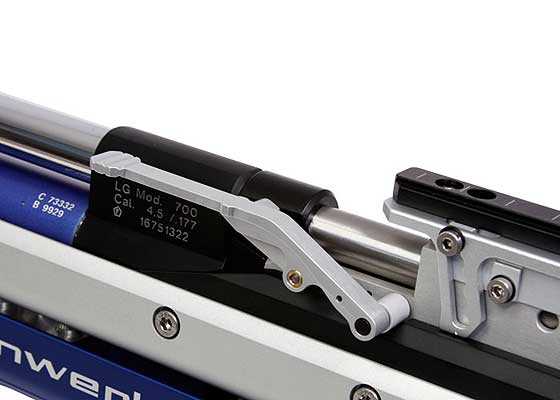 Yes, that lever on this Feinwerkbau rifle does cock the gun; and yes, it is on the side…but that doesn’t make the gun’s action a sidelever. That lever is called a flipper by shooters who borrowed the term from biathlon shooters, whose cocking levers are flippers that work back and forth.
Yes, that lever on this Feinwerkbau rifle does cock the gun; and yes, it is on the side…but that doesn’t make the gun’s action a sidelever. That lever is called a flipper by shooters who borrowed the term from biathlon shooters, whose cocking levers are flippers that work back and forth.
A sidelever refers to a cocking mechanism for a spring-piston airgun. The lever connects to the piston, pushing it back to cock the mainspring. The FWB 700 is a PCP, not a springer. The fact that it has a lever on the side is coincidental. That lever, which is properly called a flipper by the shooters who use it — is just a linkage to the bolt. Edith told me she often gets comments that are like this one, so I thought I would address this today.
A bolt-action gun has a cylindrical metal rod called a bolt, whose job is either to push the pellet into the breech or sometimes to also act as a conduit for the compressed gas that fires the pellet into the barrel. How the bolt is designed and how it works affects the accuracy of the airgun.
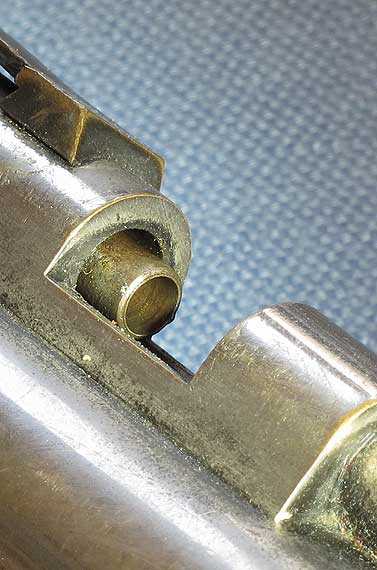
The bolt nose of the Benjamin 130 bolt is hollow — like many CO2 bolts. But this one is shaped to hold one steel BB during loading.
Only airguns today
When I talk about a bolt-action gun in this report I will be referring only to airguns. This is one area where firearms and airguns differ quite a lot.
What do bolts do?
Airgun bolts do a couple of things, and they do them to different levels of perfection. So, it’s important to know exactly what a particular bolt does if you want to know how to make a gun work its best.
The first thing an airgun bolt does is seal the compressed gas inside the barrel. Some bolts have hollow noses to conduct the compressed gas into the barrel, where it gets behind the pellet. But not all of them do. But they all seal the barrel, so the compressed gas works on just the pellet.
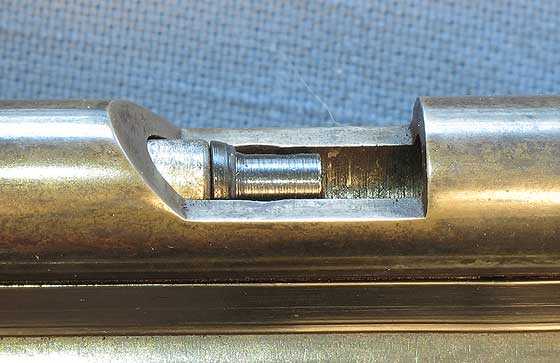
The Crosman 180 CO2 carbine has a synthetic seal that the bolt presses against the rear of the barrel to seal the gasses. This bolt is only for loading the gun. A separate cocking knob pulls the hammer back.
The second thing bolts do is push the pellets into the back of the barrel. But here’s a big distinction since the back of the barrel sometimes isn’t actually where the rifling begins. The back of the barrel may be drilled out larger than the rifling and just be a chamber where the pellet sits before firing. If the pellet does not touch rifling in this section, accuracy may suffer.
If the bolt doesn’t push the pellet into the barrel to the point that the rifling engraves it — at least on the head, if not both the head and skirt — then it’s possible that the pellet will be slammed forward on an angle and enter the rifling out-of-line with the axis of the bore when the gun fires. The angle may be slight, but it sets up an imbalance that’s acted upon by the airstream when the pellet leaves the muzzle. The drag is not aligned with the axis of the pellet and can start a small wobble as the pellet goes downrange.
Bolt probe
Some bolts have a long thin nose section that we call a probe. The probe pushes the pellet deep into the breech; because it’s thin, it also allows the maximum air to flow around it. While this sounds like such a good idea that we would want all bolts to have a probe, you have to remember that the inside of every pellet skirt is different. The probe sticks deep inside some pellets and doesn’t push them as far into the rifling. But it hits the flat wall inside other pellets and pushes them very deep.
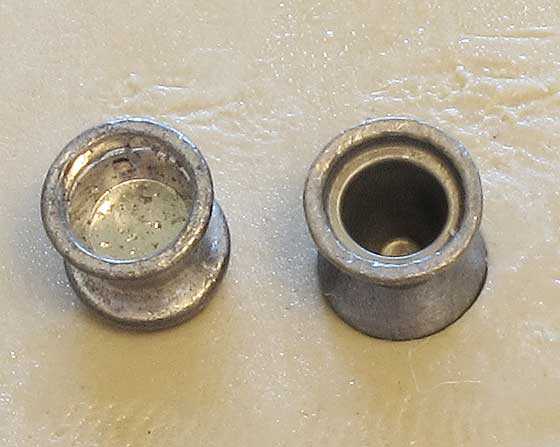
The Crosman Premier on the left has a flat wall that stops the bolt probe. The RWS Hobby on the right does not, so the probe goes in further and doesn’t push the Hobby as deep into the breech.
Repeating airguns use the bolt to push the pellet through the clip or magazine and into the breech. This is one more relationship that must be considered.
Matching the shape of the bolt nose to the pellets you use is important for accuracy. And sometimes an airgunsmith will change the shape of the bolt nose to get increased performance from a certain gun. This is very common with the vintage CO2 single-shot air pistols such as the Crosman Mark I and II and the S&W 78G and 79G.
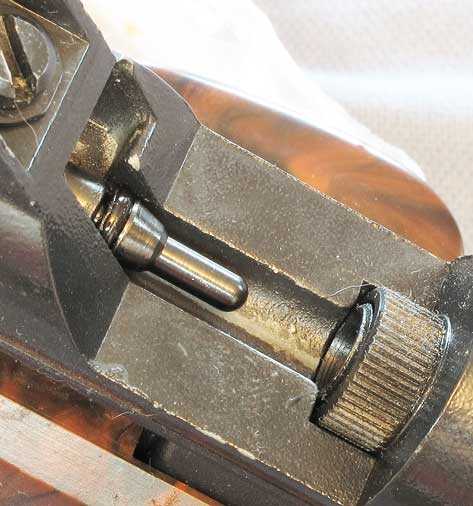
The bolt nose on this vintage Crosman Mark I target pistol is stock — just as it came from the factory. You can call this nose a probe because that’s how it works. But look at the next picture to see the contrast. Like the Crosman 180, this bolt only loads the pellet. A separate set of sliding tabs cock the hammer.
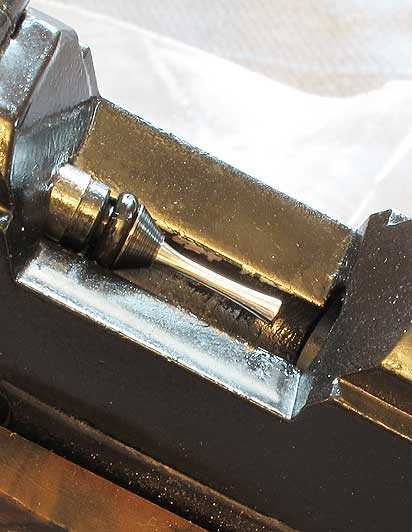
The bolt probe on this S&W 78G pistol looked like the Crosman, above, when it was new. An airgunsmith has thinned and even shaped this probe to allow gas to flow around it more easily. Just this modification by itself added velocity to the gun. This is another bolt that only loads the pellet. Cocking is done separately.
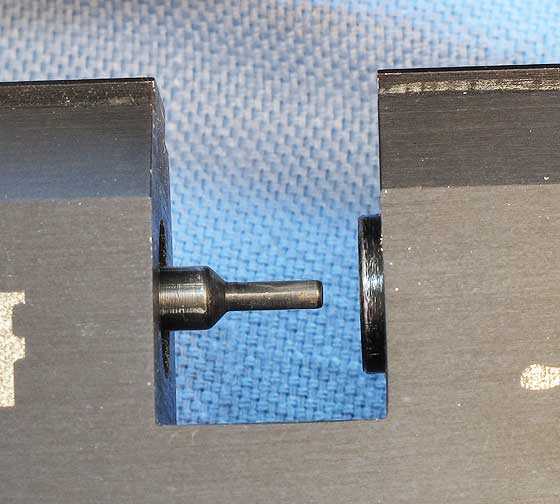
Like the custom tuners, Crosman made their Marauder bolt probe thin and long. It pushes the pellet from the magazine into the breech and also seats the pellet deep in the rifling. Because it’s thin, air flows easier around and past it, giving better efficiency.
Of course, not every bolt has a probe. Many get along very well with just a simple bolt nose that may even be flat because it fits the shape of the back of the pellets it’s designed to shoot. The Crosman-2240 air-pistol is one example of this.
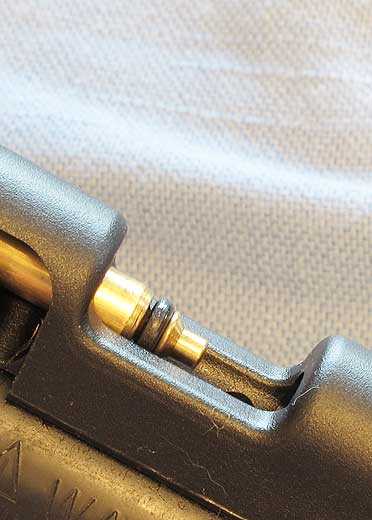
This Crosman 2240 air pistol has a brass bolt with a flat tip. There’s also an o-ring (rather than a proprietary seal) around the bolt to seal the gasses. That makes it easier and cheaper to repair.
Finally, some airguns are made to fire both steel BBs and lead pellets. People wonder how these guns are able to be rifled and still shoot steel BBs, but the factories have figured out how to do it. And, yes, the steel BB does wear the bore faster than the lead pellet. In fact, the lead pellet probably doesn’t wear a rifled steel bore at all, at least in terms we can comprehend. There are target rifles owned by clubs that have millions of shots on them and, while they look pretty doggy, their bores are like new.
A gun that shoots steel BBs probably has a flat magnet in the tip of its bolt, so there’s no possibility for a probe. On the other hand, if the tip is wide enough, it probably still shoves the pellet into the breech because the bolt will slide only a short way into the pellet’s skirt. Again, the shape of the inside of the pellet skirt will affect how this works.
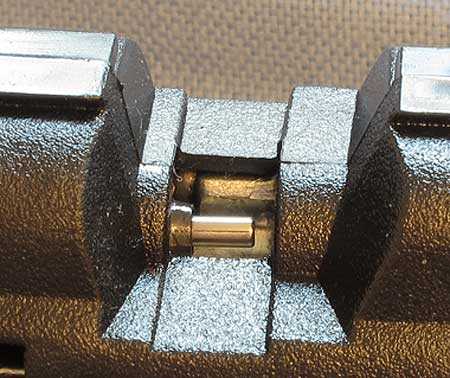
The bolt tip on this Daisy model 35 is flat, but it also contains a powerful magnet to hold steel BBs.
Summary
The bottom line is that the shape of the bolt really matters a lot for airguns. It has several jobs to do, and its shape determines how well it will do each one. The next time you look at an airgun that has a bolt, give some thought to how well the bolt tip matches the pellets you want to use.

Would it be possible to make a bolt without probe, that retracts itself when the bolt handle is turned downwards? This could be easily done by putting the bolt handle in a slot that goes downward at an angle. And it would allow the compressed air to enter the barrel without getting disturbed by the bolt probe.
Mel,
Just my thoughts on the matter. The short answer is yes. The long answer is the mechanism to do such and the small parts involved would make for the requirement of quality production cost prohibitive. You might see that on $4000 German air rifle, but you will not see that on a $25 Chinese air rifle.
I would not be surprised if BB has seen such.
Mel,
I suppose anything is possible.
B.B.
BB,
“A sidelever refers to a cocking mechanism for a spring-piston airgun.”
The lever on the FWB 70 in your photo and other PCPs is also a cocking mechanism. The sidelever on a sproinger also opens and closes the chamber.
If a lever action rifle (powder burner type) has a rotating locking bolt, is it a lever action or a bolt action?
Probably because I do not frequent the 10 meter circles, I do not recall hearing the term “flipper” used to refer to the lever on an air rifle. If I have, my mind may have written it off as an “English” term. They tend to give weird names to things.
Sorry, I just could not let you off that easy.
RR,
Ooops! You must have missed the disclaimer that this report was only about airguns, and not firearms. As I said, firearms differ from airguns in the way their bolts work and what they do.
B.B.
You are correct Tom that we’re talking about airguns not powder burners. However I agree with Ridgerunner. The system you described for the FWB 70 isn’t really a bolt-action since it has neither a straight-pull bolt (Crosman 760, Daisy 35, Daisy 880…) or a turn bolt (Marauder, Discovery, QB 78…). In fact Air Arms uses something similar on their S510 Extra FAC PCP air-rifles (and quite a few other PCP air-rifles in their line) that they explicitly call a side-lever. (Check Pyramid Air’s site if you don’t believe me about this.)
I think the confusion stems from the fact that you’re considering any airgun which has a bolt as part of its operation a bolt-action. And I don’t know if that is fair. After all, you could make an airgun where the chamber is opened, the magazine is indexed, a pellet is pushed into the chamber by a bolt, and the chamber is closed by a bolt which is all operated by the movement of a lever under the barrel. (In fact doesn’t the Sumatra 2500 which you explicitly referred to as a lever-action back in 2003 work like this?) If you ask people whether that system is a bolt-action or a lever action, the answer you get is going to be lever-action.
Don’t get me wrong, a blog entry trying to clarify what constitutes a bolt-action and how it works with airguns is helpful. Especially since I’ve seen the kids on Yahoo Answers tell me that they want a real bolt-action that cocks the gun, charges the gun, and loads the gun (usually from a magazine) not a pretend bolt-action like the Crosman 760 Mom bought them for Christmas where they have to pump the gun up and work the action. All for less than $50 mind you. But at the same time, you need to work within the paradigm which governs guns of all types when it comes to action types. And unfortunately for you, that paradigm was laid down by firearms. The archetypical bolt-actions are Mauser’s turn-bolt pattern and Manlicher’s straight pull pattern. The side-lever doesn’t fit either of those patterns. Its more of a lever-action, which is why people are disagreeing with you on this one.
J.
It’s a lever action as even with a rotating bolt.
Mike
Same way a BLR is a lever action that uses a rotating bolt similar to a bolt-action. Right Mike?
J.
Crosman 1077. I really like this rifle. As many know this is a repeater .177, CO2 rifle. It has a circular clip that holds, I think, 12 pellets. I have been shooting Hobbys through it. When I load the clip, the Hobbys fit “snug”, into the clip. I don’t think I have ever tried any other pellets than the Hobbys. I am about out of Hobbys, so I got out a tin of Beeman Lasers. The Lasers say they weigh 7.1 grains and the Hobby tin says 7.0 grains. With that I thought the Lasers would shoot about like the Hobbys. When I first started to load the Lasers into the clip, I noticed they fit the clip alot more loose than the Hobbys. With the Hobbys I have to give the pellet a little push to seat them. The Lasers went into the clip very easily, very little pressure to get them in the clip. I just put in a new CO2 cart the night before. First shot with the Lasers, missed the target low, and the sound of the rifle was very quiet. The rifle acted like it was about out of CO2. Dang, I thought, the rifle is leaking. A few more shots and the same results, no power and little noise. I switched clips to one full of Hobbys. First shot. Good power again, normal noise. ?? A few more shots with the Hobbys, all good, back to normal. Back to the Laser clip and again, no power, pellets hitting low at 10M. I guess the Lasers are so loose in the clip that they get pushed down the barrel before the CO2 builds up enough pressure to propel them up to normal velocity. Never would have guessed. I have ran a brass bore brush into the clip to reduce friction, thinking less friction would be more accurate, but I guess too little friction is not good either.
I Tried AA Diabolo’s in my 1077 and it hated them, i find this rifle does a lot better on flat headed pellets. Put that one down to experience.
All the best.
Wing Commander Sir Nigel Tetlington-Smythe.
Off topic tip…
AF sound lock kit….
Push the baffles in one at a time with a dowel. They fit my SS very tight. Difficult enough with one baffle. Would be much worse trying to push all three down at the same time.
twotalon
TT.
Cool you got the kit. I don’t remember if you said what cal. your gun is. Was just wondering.
And mine didn’t fit that tight in my gun. Hmm ?
GF1…
My SS is .177.
Not sure if it is any quieter than my previous arrangement.
Checked out the pellets I received today. They are fine.
Filled and checked a new spare tank for the T200. No need to adjust the striker preload, or the fill pressure. Works just like the original.
twotalon
My gun is definitely quieter with the kit.
On your original set up did you have anything else done besides the holes drilled?
GF1..
Had four chambers of unequal length. Did not produce a sharp snap in reflected noise. That sound is to be avoided. Gets too much attention from neighbors and starlings.
I may end up pulling the kit back out. Too humid and hot today for testing. 87 degrees and 98% humidity. Anything taken outside will sweat horribly.
twotalon
TT.
What did you make the chambers out of that you had in your gun? That’s what I’m trying to get away from is the sharp snap.
And agree with you about the heat and humidity. And I got to go to work right now at the machine shop. Maybe I will get lucky tonight and get to make something in the tool room.(only place that has A/C). I hope.
GF1..
I used PVC pipe and fender washers. Had to turn the PVC down a bit to get it to fit. The fender washers were a bit oversized, and had holes too small in the center. Had to “adjust” them to fit just right, and with the holes just larger than a pellet. The tighter you can get the hole without clipping, the better it works.
twotalon
TT.
There’s a couple of interesting things you have mentioned above that hit it on the money.
And I believe that is why your setup is working good.
First is the hole diameter that the pellet passes through definitely needs to be as close as possible to the pellet diameter.
The holes in the baffles that came with my Sound Loc Kit were .218″ (to big for a .177 pellet and to small for .22 pellet) and yes I got the .177 kit.
Mike T. that make the TKO muzzle brakes will ream that hole tighter for somebody when they order if they specify. But it takes more care to get the brake lined up correct. But definitely makes a difference with the hole size.
The second is that your pvc design is pretty much the same as the Marauder baffle design.
Now I got to go take my shroud of my .177 Marauder and see if the outside diameter of the baffles will slip inside the TSS tube.
You know what I’m going to try next if they fit.
Wrong outside diameter.
In my collection I have bolt action, break barrel, side lever, under lever, semi-auto and even some full auto and pcp. My favorites are my pcp guns which are bolt action. Although I’m mot entirely sure what you’d call the Airforce guns since they do not technically have a bolt or a bolt probe anywhere on them. Those are kind of a mutant I guess.
John,
AirForce calls the sliding barrel cover that you push forward to cock the gun a bolt. I disagree, but that’s their terminology. It doesn’t function like a bolt in any way except sealing the barrel.
B.B.
If that is what they want to call it I guess that will do. But I tent to agree with you on that. It isn’t what I’d call a bolt. I examined this thing a bit and figured out it functions more like a Newton’s cradle. The striker hits this “bolt” which causes it to strike the air valve and release some air through the hole in this thing which sends the pellet. It seems to direct the air more than anything from my examination of it. But whatever it is, the gun is superior to every other gun I own.
Mr. BB, very cool & great pics, thanx!
Shoot/ride safe,
Beaz
Speaking of bolt-action air rifles… Any chance we’ll see a left-handed marauder one of these years? Since the stock is ambidextrous, and since the handle comes out the rear of the receiver, seems like it might not be so hard to make a few with a left-handed action for us lefties.
American Airgunner today at 4:30 on 393 Pursuit channel .(Dish network).
Should be a new one.
twotalon
I’ll make an excursus into firearms. Does a “bolt-action” necessarily have a rotating bolt? Can a straight pull rifle like the Swiss K31 be a bolt-action?
B.B., so how do Anschutz, Feinwerkbau and the other elites mass produce their top quality barrels? Do they do final hand adjustments like Savage?
I just received my Mosin sniper in the mail yesterday! Unfortunately, I won’t be able to take it shooting until next month. But I can say that my $80 Huber match trigger works great. It is very light at four and a quarter pounds with a crisp single stage let off. If anyone is looking to upgrade their Mosin, this is a good deal. Moreover, the design is a modification of the original trigger that introduces a ball bearing, and it doesn’t require any permanent modification of the rifle. If you don’t like it, you can just replace it with the original trigger.
Having all the old soldiers together in the form of my surplus rifles, I must say that there is nothing quite like running the Lee-Enfield with that that smooth cock-on-closing action. If you’re fond of the bolt-action experience, this is the summit.
Matt61
Matt,
They button rifle them. They use the finest steel in the blanks and they spend more time reaming the blanks before rifling.
The top makers then lap their barrels, which the mass makers don’t do. That step, alone, makes a big difference.
B.B.
And yet, each barrel still has to be matched with the right ammo. Some swear that Eley Match (black) shoots better in their rifles than Eley Tenex (red). I’ve demonstrated that mixing lots of Eley Tenex produce differences of 2 inches. That’s why you MUST buy your match ammo in large quantities of the same lot, usually a case worth.
In my lexicon, a “bolt action” is one in which the cocking “handle” (to avoid confusing terms) is something affixed perpendicular to the bolt, and does not, of itself, incorporate a mechanism in which it moves at a different rate from said bolt when cycling the action.
Rotation to unlock the bolt is not a “different rate” action.
In contrast, lever actions have a mechanism in which the bolt moves one way while the lever is moving in a different plane, and possibly with a force multiplication (if you have a stuck case, the bolt action may only have an “assist” provided by a slanted path for the handle to move in, but once the rotation is fully up, any rearward force is strictly that of one’s hand tugging the handle; A lever action, OTOH, is — well — a lever, a long stroke of the lever handle produces a shorter stroke of the bolt, and a force multiplication to help pull the case from the chamber…)
To me a ‘bolt action’ is what I perform out the back door when the mother-in-law shows up unexpectedly.
Now that’s the best explanation of a bolt action that I have heard of yet.
BB, off subject, I see in the “new” section of PA they show a Webley Stingray. Thoughts on this gun? The reason I ask, it’s velocity of the .22 is just fps, giving me hope of a good shooter that isn’t so hold sensitive. I also see Webley Valuemax, although a much more powerful gun. I really don’t know much about Webley (quality and so on). Crosman emailed me, telling me the Jim Shockey Signature Series (.22) is now in stock. I wonder if this gun with be worth the price, or just another so so shooter with a higher price due to the Shockey name on it. Thanks again for all the great reads. So much valuable info you put out! Bradly
Bradley,
Webley is no longer the company they used to be. They used to make fine airguns in England. Now they source them from other countries, currently Turkey. So the Stingray is actually a spring rifle made in Turkey.
As for the Jim Shockey series, that’s an endorsement deal Crosman has with Shockey. I don’t have any information or experience with these guns, so I can’t comment.
B.B.
B.B., Thanks for clearing that up for me. I knew something was right. When I was much younger I seemed to recall that a Webley was “high” priced for me. Now they seem much cheaper. Being made in Turkey would explain that, so Thank You for that information. Bradley
Thanks B.B. for clarifying.
Pyramyd’s site had the various Feinwerkbau products (flipper equipped) listed both ways. (bolt and side lever)
Yes, I am the whistle blower.
From my perspective, it was a good way to earn 200 Bullseye Bucks by pointing out the inconsistency.
More trivia.
Sam Yang 909S. (and others)
Listed as a bolt action by Pyramyd AIR.
Cocking lever only sets the spring/hammer prior to firing which causes a valve to be struck, releasing air for the shot.
Nothing pushes the pellet or ball into the breech. (Other than the shooter with a pellet seating tool of some sort.)
Sliding cover with dual o-rings provides sealing as well as access to the loading area.
Action type?
bolt probe air gun design differs a lot compared to hollow nose designs … which is best?
boltaction,
I don’t understand your question. Which is better, good food or a vacation?
B.B.
hahaha! I mean which of the two designs is best in case we make our own air gun? I am an avid reader of your blog for almost two years.
boltaction,
It depends on what you are shooting. Hollow noses work best for BB guns. Long bolt probes work best for lead pellets.
B.B.
One of the modifications made to my Crosman 2240 was a flow thru bolt by Mellonaire. The tip of the bolt is flat. What pellet(s) would you suggest I try ? Really enjoyed this very informative article. ( Except for the nit pickers going on about the definition of bolt action.)
Tom,
With a Crosman barrel I would always start with a Premier pellet. It has that flat inside for the bolt probe to push against and Crosman barrels seem to do well with Crosman pellets.
Try a JSB Exact 15.9-grain after that.
B.B.
Neglected to say the barrel is also by Mellon. 12 inches. Also have the long steel breach by Crosman. My concern is: After reading the above article I put an RWS 11.9g hobby pellet in the original plastic breech and loaded into the original barrel. Then pulled the barrel out of the breach and the pellet did not clear the port in the barrel. That is with the original “pointed ‘ probe. Also tried a Crosman 14.3 g pointed and a 14.3g hollowpoint. They both cleared the port. The Mellon bolt and the original Crosman bolt are the samet lenghth- just under 4.5 cm. As per your article, the more rifling the pellet engages equals better accuracy-which I’m more concerned with than power. Am I missing something? Thanks for your prompt reply.
Tom,
I think you have the idea. Try the Premiers first.
B.B.
The bolt probe on this S&W 78G pistol looked like the Crosman, above, when it was new. An airgunsmith has thinned and even shaped this probe to allow gas to flow around it more easily. Just this modification by itself added velocity to the gun. This is another bolt that only loads the pellet. Cocking is done separately.